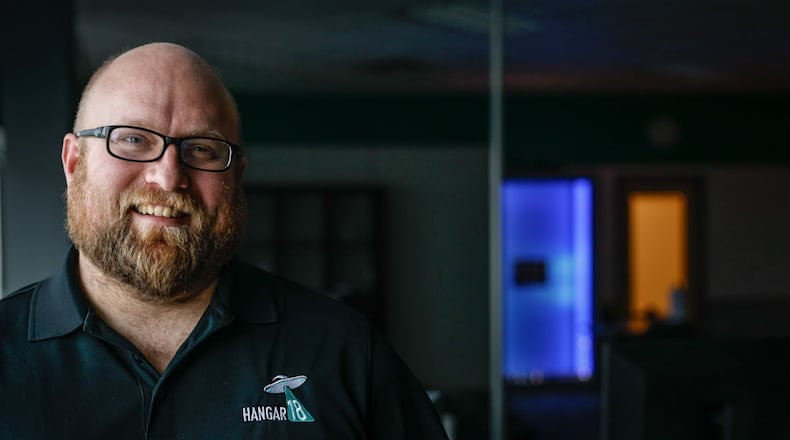No one remembers the notebook a scientist used to write down data in a key discovery, Jacobsen said. What they remember is the discovery — the data itself.
“It’s not just building software, but also building software with an eye on the data that’s being generated and making sure we have a maximum amount of exploitability of that data,” Jacobsen said in a new interview.
Named after the mythical alien-hiding hangar of yore, Hangar 18 is made up of nearly 80 mostly Dayton-area Air Force employees and contractors who produce and refine software for AFRL and others.
“We might work with the Army,” Jacobsen said. “We might work with the Navy. It’s all part of the whole governance framework that I had to put together for Hangar 18, to make sure that our leadership and sponsors were comfortable with the kind of work we were doing.”
What follows is an edited transcript of a nearly 45-minute interview with Jacobsen and the Dayton Daily News.
What is a software factory?
Matt Jacobsen: “The interesting thing about that is, there really is no playbook.
“The software factory has been given a lot of leeway in terms of figuring out their own playbook — what their charter is and what they’re supposed to be doing. And in a lot of ways, that’s a good thing. We’ve been given a lot of autonomy.
“There’s an assumption that the factories are using DevSecOps, best practices, they’re using agile, they’re using user-centered design.”
When the Air Force uses terms like ‘agile’ and ‘DevSecOps,’ what do those mean?
Jacobsen: “On the agile side, it is getting to capability as early as possible and continuously. It’s not waiting a year, two years, three years for a large software capability to fall out of the sky into your lap and hope you’ve got all your requirements ready. That’s called a ‘waterfall.’ We don’t do waterfalls, as much as possible. We get in there early, we do exploring, we do prototyping …
“And one of the ways that we get around a waterfall … is by working closely with the end-user. Who are we building this for? Boy, does that matter. If we’re ever not sure who we’re serving, it’s time to pause and re-evaluate the landscape.
“On the DevSecOps side, what we mean is factoring in our security and operational constraints into our designs. It’s not just about writing code. It’s about saying, where will this thing live?”
Can you give an example of a problem you solve or a product you offer?
Jacobsen: “Hyperthought is a system that my team and AFRL have been working on for the better part of 10 years. I’m the technical lead for that. That is focused on improving how we work with research data. What is the product of AFRL? We don’t build planes and bombs at AFRL. Our product is research. It’s information. It’s data. How do we get our arms around that as an organization? So my team built this data platform called ‘Hyperthought.’
“We learned an awful lot about how to govern and manage data across different research domains. This is actually what prompted us to raise our hand and say, ‘Yeah, we’d like to do a software factory, where we focus not just on software, but on data.’
“Borrowing a little bit from Bill Gates — Bill Gates said back in the day that, ‘Research at the speed of thought.’ That’s been my sort of catchphrase for that system.”
Is it fair to say you’re anchored at Wright-Patterson Air Force Base, even if you have some employees working from remote locations?
Jacobsen: “Yeah, we put Dayton on the map, man. We said, ‘Why doesn’t Dayton have a software factory?’ There was a whole slide deck we put together. Why doesn’t Wright-Patt have a software factory?”
About the Author

